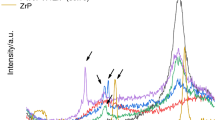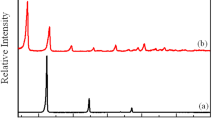Abstract
Biodegradable ternary systems based on poly(vinyl alcohol)/poly(N-vinyl-2-pyrrolidone)/octadecylamine-containing zirconium phosphate were studied. Firstly, the synthesis and intercalation of lamellar zirconium phosphate were accomplished. As precursors, phosphoric acid (H3PO4) and zirconium(IV) oxide chloride 8-hydrate (ZrOCl2·8H2O) were used in the ratio P:Zr equals 18. ZrP d-spacing was expanded by octadecylamine as an intercalating agent using 1:1 amine:ZrP molar ratio. Ternary systems based on mixing of PVA and PVP water solution at different proportions (30/70, 50/50 and 70/30 mass/mass%) plus the addition of ZrPOct (2 mass%) were carried out. Infrared spectroscopy revealed that the interaction of PVA and ZrPOct was prominent evidencing an action of octadecylamine as compatibilizing agent. X-ray diffraction showed the decrease in PVA crystal size and the ZrPOct new diffraction angles as a function of the arrangement of polymers inside of the ZrPOct. Mass loss derivative thermogravimetric curves indicated polymer segregation and the decrease in PVA rich phase thermal stability. PVA crystallinity degree (Xc), cold crystallization and melting temperatures (Tcc and Tm) were drastically influenced by PVA/PVP compositions and ZrPOct. Dynamic-mechanical measurements supported that octadecylamine altered the polymer–polymer interaction acting as compatibilizing agent. Also, multiphase systems were reached owing to the free and linked octadecylamine molecules which provided variable polymer molecular motion and PVA/PVP participation effectiveness degree of each rich phase. The system was thought for future application as a control drug delivery.











Similar content being viewed by others
References
Zhang H, Wang X, Huang H, Yang B, Wang C, Sun H. Nanocomposite interpenetrating hydrogels with high toughness and good self-recovery. Colloid Polym Sci. 2019. https://doi.org/10.1007/s00396-019-04512-7.
Fan C, Pan W, Wang W, Rao Q, Yan A, Chen S, et al. Sol-gel synthesis of cerium dioxide nanoparticles coated with stimuli-responsive components and the application for conversion of d-(−)-fructose into platform molecules. J Sol-Gel Sci Technol. 2018. https://doi.org/10.1007/s10971-018-4771-2.
Brza MA, Shujahadeen BA, Anuar H, Al Hazza MHF. From green remediation to polymer hybrid fabrication with improved optical band gaps. Int J Mol Sci. 2019. https://doi.org/10.3390/ijms20163910.
Shah J, Ranjan M, Sooraj KP, Sonvane Y, Gupta SK. Surfactant prevented growth and enhanced thermophysical properties of CuO nanofluid. J Mol. 2019. https://doi.org/10.1016/j.molliq.2019.03.127.
Shabanpanah S, Omrani A. Influences of crosslink density on the performance of PVA–diphenylamine-4-sulfonic acid sodium salt composite membranes. Solid State Ion. 2019. https://doi.org/10.1016/j.ssi.2019.05.003.
Liu H, Jian R, Chen H, Tian X, Sun C, Zhu J, Yang Z, Sun J, Wang C. Application of biodegradable and biocompatible nanocomposites in electronics: current status and future directions. Nanomater-Basel. 2019. https://doi.org/10.3390/nano9070950.
Basha SKS, Rao MC. Spectroscopic and electrochemical properties of PVP based polymer electrolyte films. Polym Bull. 2018. https://doi.org/10.1007/s00289-017-2229-2.
Sreekanth K, Siddaiah T, Gopal NO, Kumar YM, Ramu C. Optical and electrical conductivity studies of VO2+ doped polyvinyl pyrrolidone (PVP) polymer electrolytes. J Sci Adv Mater Dev. 2019. https://doi.org/10.1016/j.jsamd.2019.06.002.
Kimaro E, Tibalinda P, Shedafa R, Temu M, Kaale E. Formulation development of chewable albendazole tablets with improved dissolution rate. Heliyon. 2019. https://doi.org/10.1016/j.heliyon.2019.e02911.
Arya A, Sharma AL. Optimization of salt concentration and explanation of two peak percolation in blend solid polymer nanocomposite films. J Solid State Electr. 2018. https://doi.org/10.1007/s10008-018-3965-4.
Kamoun EA, Kenawy ES, Chen X. A review on polymeric hydrogel membranes for wound dressing applications: PVA-based hydrogel dressings. J Adv Res. 2017. https://doi.org/10.1016/j.jare.2017.01.005.
Suchomel P, Kvitek L, Panacek A, Prucek R, Hrbac J, Vecerova R, Zboril R. Comparative study of antimicrobial activity of AgBr and Ag nanoparticles (NPs). PLoS ONE. 2015. https://doi.org/10.1371/journal.pone.0119202.
Li CC, Li MJ, Huang YP. Dispersion of aluminum-doped zinc oxide nanopowder with high solid content in ethylene glycol. Powder Technol. 2018. https://doi.org/10.1016/j.powtec.2017.12.047.
Arias LS, Pessan JP, Vieira APM, Lima TMT, Delbem ACB, Monteiro DR. Iron oxide nanoparticles for biomedical applications: a perspective on synthesis, drugs, antimicrobial activity, and toxicity. Antibiotics. 2018. https://doi.org/10.3390/antibiotics7020046.
Zhao F, Yao D, Guo R, Deng L, Dong A, Zhang J. Composites of polymer hydrogels and nanoparticulate systems for biomedical and pharmaceutical applications. Nanomater-Basel. 2015. https://doi.org/10.3390/nano5042054.
Mallakpour S, Khani M. Thermal and morphological studies of poly(vinyl alcohol)/poly(vinyl pyrrolidone)/organoclay nanocomposites containing l-leucine moiety. Colloid Polym Sci. 2016. https://doi.org/10.1007/s00396-015-3820-4.
Bunyatova U, Rzayev Z, Koçum IC, Simsek M, Yürüksoy MB. Fabrication and characterization of AgNPs incorporated PVA/ODA-MMT and PVP/ODA-MMT nanofiber structures by green electrospinning nanotechnology as excellent conducting and bioengineering nanomaterial. Acta Phys Pol. 2016. https://doi.org/10.12693/APhysPolA.129.431.
Bunyatova U, Rzayev ZMO, Şimşek M. Multifunctional e-spun colloidal nanofiber structures from various dispersed blends of PVA/ODA-MMT with PVP/ODA-MMT, poly(VP-alt-MA) and AgNPs incorporated polymer complexes as electro-active platforms. Express Polym Lett. 2016. https://doi.org/10.3144/expresspolymlett.2016.55.
Yang Y, Liu C, Wu H. Preparation and properties of poly(vinyl alcohol)/exfoliated α-zirconium phosphate nanocomposite lms. Polym Test. 2009. https://doi.org/10.1016/j.polymertesting.2008.12.008.
Mendes LC, Silva DF, Araujo LJF, Lino AS. Zirconium phosphate organically intercalated/exfoliated with long chain amine). J Therm Anal Calorim. 2014. https://doi.org/10.1007/s10973-014-4056-0.
Sue HJ, Gam KT, Bestaoui N, Spurr N, Cleareld A. Epoxy nanocomposites based on the synthetic α-zirconium phosphate layer structure. Chem Mater. 2004. https://doi.org/10.1021/cm030441s.
Boo WJ, Sun L, Liu J, Cleareld A, Sue H. Effective intercalation and exfoliation of nanoplatelets in epoxy via creation of porous pathways. J Phys Chem C. 2007. https://doi.org/10.1021/jp072227n.
Garcia EE, Freitas DFS, Cestari SP, Coval DR, Mendes LC, Albitres GAV. Zirconium phosphate changing hygroscopicity of polyamide-6 in nanocomposites PA-6/ZrP. J Therm Anal Calorim. 2019. https://doi.org/10.1007/s10973-019-08396-1.
Mariano DM, Freitas DFS, Mendes LC, Carvalho ALF. Ramos FJHTV, investigation on structural, morphological and relaxometric properties of lamellar Zrp modified with long chain amine. Mater Res. 2019. https://doi.org/10.1590/1980-5373-mr-2018-0493.
Albitres GAV, Cestari SP, Freitas DFS, Rodrigues DC, Mendes LC, Neumann R. Intercalation of α-titanium phosphate with long-chain amine aided by short-chain amine. Appl Nanosci. 2020. https://doi.org/10.1007/s13204-019-01176-1.
Freitas DFS, Mendes LC. Water resistance, mechanical, and morphological characteristics in polyamide-6/zirconium phosphate nanocomposites. J Compos Mater. 2019. https://doi.org/10.1177/0021998319857120.
Brandão LS, Mendes LC, Medeiros ME, Sirelli L, Dias ML. Thermal and mechanical properties of poly(ethylene terephthalate)/lamellar zirconium phosphate nanocomposites. J Appl Polym. 2006. https://doi.org/10.1002/app.24096.
Carvalho ALF, Freitas DFS, Mariano DM, Mattos GC, Mendes LC. The influence of zinc gluconate as an intercalating agent on the structural, thermal, morphologic, and molecular mobility of lamellar nanofiller. Colloid Polym Sci. 2018. https://doi.org/10.1007/s00396-018-4319-6.
Lino AS, Silva DFS, Mendes LC, Malm O. High density polyethylene and zirconium phosphate nanocomposites. Polímeros. 2015. https://doi.org/10.1590/0104-1428.2030.
Albitres GAV, Cestari SP, Macedo KRM, Mendes LC, Cruz MO, Filho MF, Araújo AS. Poly(ethylene terephthalate)/titanium phosphate nanocomposites: effect of fillers on thermal, crystallographic diffraction, molecular mobility, and UV–Vis absorption. J Thermoplast Compos Mater. 2019. https://doi.org/10.1177/0892705719886926.
Freitas DFS, Mattos GC, Mendes LC. Investigation on miscibility, thermal, crystallographic diffraction and dynamic mechanical properties of poly(vinyl alcohol)/poly(vinylpyrrolidone)/zirconium phosphate nanocomposites. J Therm Anal Calorim. 2020. https://doi.org/10.1007/s10973-020-09599-7.
De Souza AO, Rangel MD, Alves OL. Synthesis and characterization of alpha-zirconium(IV) hydrogenphosphate containing metallic copper clusters. Quim Nova. 2005. https://doi.org/10.1590/S0100-40422005000100009.
Auerbach SM, Carrado KA, Dutta PK. Handbook of layered materials. M. Dekker, 2004. ISBN 9780824753498.
ASTM D3418-15 American Society for Testing and Materials, Standard Test Method for Transition Temperatures and Enthalpies of Fusion and Crystallization of Polymers by Differential Scanning Calorimetry.
Campos A, Marconato JC, Martins-Franchetti SM. Biodegradation of blend films PVA/PVC, PVA/PCL in soil and soil with landfill leachate. Braz Arch Biol Technol. 2011. https://doi.org/10.1590/S1516-89132011000600024.
Lewandowska K. The miscibility of poly(vinyl alcohol)/poly(N-vinylpyrrolidone) blends investigated in dilute solutions and solids. Eur Polym J. 2005. https://doi.org/10.1016/j.eurpolymj.2004.08.016.
Turaga U, Singh V, Behrens R, Korzeniewski C, Jinka S, Smith E, Kendall RJ, Ramkumar S. Breathability of standalone poly(vinyl alcohol) nanofiber webs. Ind Eng Chem Res. 2014. https://doi.org/10.1021/ie5005465.
Abdelrazek EM, Elashmawi IS, Labeeb S. Chitosan filler effects on the experimental characterization, spectroscopic investigation and thermal studies of PVA/PVP blend films. Phys B. 2010. https://doi.org/10.1016/j.physb.2010.01.095.
Shi Y, Xiong D, Liu Y, Wang N, Zhao X. Swelling, mechanical and friction properties of PVA/PVP hydrogels after swelling in osmotic pressure solution. Mater Sci Eng C-Mater. 2016. https://doi.org/10.1016/j.msec.2016.04.042.
Abou-Taleb MH. Thermal and spectroscopic studies of poly(N-vinyl pyrrolidone)/poly(vinyl alcohol) blend films. J Appl Polym Sci. 2009. https://doi.org/10.1002/app.30082.
Mondal D, Mollick MMR, Bhowmick B, Maity D, Bain MK, Rana D, Mukhopadhyay A, Dana K, Chattopadhyay D. Effect of poly(vinyl pyrrolidone) on the morphology and physical properties of poly(vinyl alcohol)/sodium montmorillonite nanocomposite films. Prog Nat Sci Mater. 2013. https://doi.org/10.1016/j.pnsc.2013.11.009.
Díaz A, Mosby BM, Bakhmutov VI, Martí AA, Batteas JD, Clearfield A. Self-assembled monolayers based upon a zirconium phosphate platform. Chem Mater. 2013. https://doi.org/10.1021/cm303610v.
Mendes LC, Rodrigues RC, Silva EP. Thermal, structural and morphological assessment of PVP/HA composites. J Therm Anal Calorim. 2010. https://doi.org/10.1007/s10973-010-0835-4.
Kumar S, Prajapati GK, Saroj AL, Gupta PN. Structural, electrical and dielectric studies of nano-composite polymer blend electrolyte films based on (70–x) PVA–x PVP–NaI–SiO2. Phys B Condens. 2019. https://doi.org/10.1016/j.physb.2018.11.010.
Lorıa-Bastarrachea MI, Herrera-Kao W, Cauich-Rodrıguez JV, Cervantes-Uc JM, Vazquez-Torres H, Avila-Ortega A. A TG/FTIR study on the thermal degradation of poly(vinyl pyrrolidone). J Therm Anal Calorim. 2011. https://doi.org/10.1007/s10973-010-1061-9.
Mendes LC, Tavares MIB, Mano EB. Compatibility of iPP/HOCP binary blends by OM, DSC, DMTA and 13C nuclear magnetic resonance. Polym Test. 1996. https://doi.org/10.1016/0142-9418(95)00027-5.
Liu T, Petermann J. Multiple melting behavior in isothermally cold-crystallized isotactic polystyrene. Polymer. 2001. https://doi.org/10.1016/S0032-3861(01)00173-2.
Rajeswari N, Selvasekarapandian S, Karthikeyan S, Sanjeeviraja C, Iwai Y, Kawamura J. Structural, vibrational, thermal, and electrical properties of PVA/PVP biodegradable polymer blend electrolyte with CH3COONH4. Ionics. 2013. https://doi.org/10.1007/s11581-012-0838-1.
Acknowledgements
The authors thank Conselho Nacional de Desenvolvimento Científico e Tecnológico (CNPq), Fundação Coordenação de Aperfeiçoamento de Pessoal de Nível Superior (CAPES) and Universidade Federal do Rio de Janeiro (UFRJ) for supporting this work.
Author information
Authors and Affiliations
Corresponding author
Additional information
Publisher's Note
Springer Nature remains neutral with regard to jurisdictional claims in published maps and institutional affiliations.
Rights and permissions
About this article
Cite this article
Freitas, D.F.S., Mattos, G.C. & Mendes, L.C. The role of octadecylamine as zirconium phosphate intercalating agent on poly(vinyl alcohol)/poly(N-vinyl-2-pyrrolidone) biodegradable systems. J Therm Anal Calorim 147, 315–325 (2022). https://doi.org/10.1007/s10973-020-10278-w
Received:
Accepted:
Published:
Issue Date:
DOI: https://doi.org/10.1007/s10973-020-10278-w




